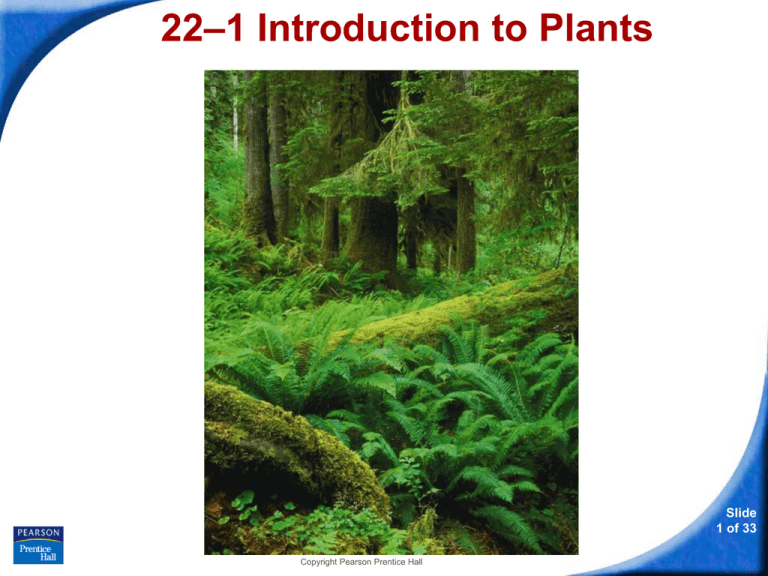
22–1 Introduction to Plants
Slide
1 of 33
Copyright Pearson Prentice Hall
22–1 Introduction to Plants
What Is a Plant?
What Is a Plant?
Plants are multicellular eukaryotes that
have cell walls made of cellulose.
Plants develop from multicellular embryos
and carry out photosynthesis using the
green pigments chlorophyll a and b.
Slide
2 of 33
Copyright Pearson Prentice Hall
22–1 Introduction to Plants
What Is a Plant?
Plants include trees, shrubs, and grasses, as well as
other organisms, such as mosses and ferns.
Most plants are autotrophs, although a few are
parasites or saprobes that live on decaying materials.
Slide
3 of 33
Copyright Pearson Prentice Hall
22–1 Introduction to Plants
The Plant Life Cycle
The Plant Life Cycle
Plant life cycles have two alternating phases, a
diploid (2N) phase and a haploid (N) phase, known
as alternation of generations.
Slide
4 of 33
Copyright Pearson Prentice Hall
22–1 Introduction to Plants
The Plant Life Cycle
Alternation of
Generations
Slide
5 of 33
Copyright Pearson Prentice Hall
22–1 Introduction to Plants
The Plant Life Cycle
During the two phases of the life cycle, mitosis and
meiosis alternate to produce the two types of
reproductive cells—gametes and spores.
The diploid (2N) phase is called the sporophyte, or
spore-producing plant.
The haploid (N) phase is called the gametophyte, or
gamete-producing plant.
Slide
6 of 33
Copyright Pearson Prentice Hall
22–1 Introduction to Plants
The Plant Life Cycle
Plant spores are haploid (N) reproductive cells
formed in the sporophyte by meiosis.
The spores can grow into new organisms called
gametophytes.
A gamete is a reproductive cell produced by mitosis,
and it can fuse with another gamete to produce the
sporophyte.
Slide
7 of 33
Copyright Pearson Prentice Hall
22–1 Introduction to Plants
What Plants Need to Survive
What Plants Need to Survive
In order to survive, plants need:
• sunlight
• water and minerals
• gas exchange
• transport of water and nutrients
throughout the plant body
Slide
8 of 33
Copyright Pearson Prentice Hall
22–1 Introduction to Plants
What Plants Need to Survive
Sunlight
Plants use energy from sunlight to carry out
photosynthesis.
Photosynthetic organs such as leaves are broad
and flat to maximize light absorption.
Slide
9 of 33
Copyright Pearson Prentice Hall
22–1 Introduction to Plants
What Plants Need to Survive
Water and Minerals
All cells require a constant supply of water.
Water is used up quickly when the sun is shining.
As a result, plants have structures that limit water
loss.
Slide
10 of 33
Copyright Pearson Prentice Hall
22–1 Introduction to Plants
What Plants Need to Survive
As they absorb water, plants also absorb minerals.
Minerals are nutrients in the soil needed for plant
growth.
Slide
11 of 33
Copyright Pearson Prentice Hall
22–1 Introduction to Plants
What Plants Need to Survive
Gas Exchange
Plants require oxygen to support cellular
respiration as well as carbon dioxide to carry out
photosynthesis.
They must exchange these gases with the
atmosphere without losing excessive amounts of
water through evaporation.
Slide
12 of 33
Copyright Pearson Prentice Hall
22–1 Introduction to Plants
What Plants Need to Survive
Movement of Water and Nutrients
Plants take up water and minerals through their
roots, but they make food in their leaves.
Most plants have specialized tissues that carry
water and nutrients from the soil and distribute
products of photosynthesis throughout the plant
body.
Simpler plants carry out these functions by
diffusion.
Slide
13 of 33
Copyright Pearson Prentice Hall
22–1 Introduction to Plants
Early Plants
Early Plants
When plants first appeared, life on Earth changed.
As plants colonized the land, they changed the
environment so other organisms could develop.
New ecosystems arose, and organic matter began
to form soil.
Slide
14 of 33
Copyright Pearson Prentice Hall
22–1 Introduction to Plants
Early Plants
The first plants evolved from an organism
similar to the multicellular green algae
living today.
Slide
15 of 33
Copyright Pearson Prentice Hall
22–1 Introduction to Plants
Early Plants
Multicellular green algae have the size, color, and
appearance of plants.
They have reproductive cycles similar to those of
plants.
Green algae also have cell walls and photosynthetic
pigments that are identical to those of plants.
Slide
16 of 33
Copyright Pearson Prentice Hall
22–1 Introduction to Plants
Early Plants
The First Plants
DNA sequences confirm that plants are closely
related to certain groups of green algae,
suggesting that the ancestors of the first plants
were indeed algae.
Slide
17 of 33
Copyright Pearson Prentice Hall
22–1 Introduction to Plants
Early Plants
The oldest known plant fossils, about 450 million
years old, are similar to today’s mosses.
They had a simple structure and grew close to the
ground.
Slide
18 of 33
Copyright Pearson Prentice Hall
22–1 Introduction to Plants
Early Plants
Fossils suggest that the first plants needed water to
complete their life cycles.
The demands of life on land favored the evolution of
plants that were:
• more resistant to the drying rays of the sun.
• more capable of conserving water.
• more capable of reproducing without water.
Slide
19 of 33
Copyright Pearson Prentice Hall
22–1 Introduction to Plants
Early Plants
From these plants, several major groups of plants
evolved.
• One group developed into the mosses and their
relatives.
• Another group gave rise to all other plants.
All plants have evolved different adaptations for a
variety of terrestrial environments.
Slide
20 of 33
Copyright Pearson Prentice Hall
22–1 Introduction to Plants
Overview of the Plant Kingdom
Overview of the Plant Kingdom
Plants are divided into four groups based on these
features:
• water-conducting tissues
• seeds
• flowers
Plants are also classified by other features,
including reproductive structures and body plan.
Slide
21 of 33
Copyright Pearson Prentice Hall
22–1 Introduction to Plants
Overview of the Plant Kingdom
Evolutionary Relationships Among Plants
Flowering plants
Cone-bearing plants
Ferns and
their relatives
Flowers; Seeds
enclosed in fruit
Mosses and
their relatives
Seeds
Water-conducting (vascular)
tissue
Green algae
ancestor
Slide
22 of 33
Copyright Pearson Prentice Hall







